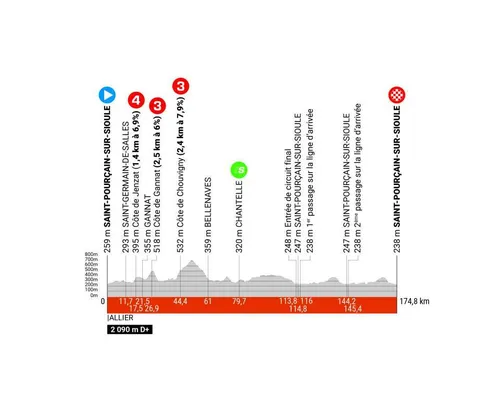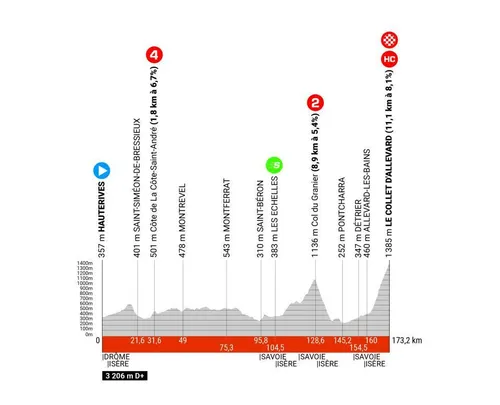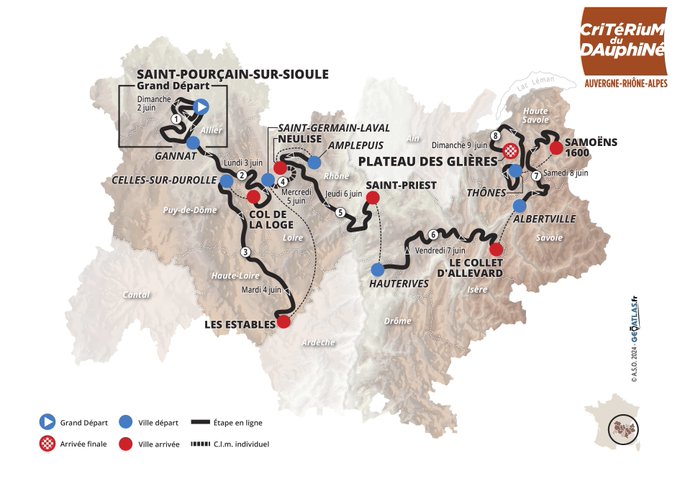
The Criterium du Dauphiné is the first World Tour event following the Giro d'Italia and traditionally, the most important race in preparation for the Tour de France. Here we will have many of the Tour's stars battling it out on all kinds of terrain including the high mountains from the 2nd to the 9th of June. We take a look at it's profiles.
Read also

Stage 1: Saint-Pourçain-sur-Sioule - Saint-Pourçain-sur-Sioule, 174.8 kilometers
The race starts off in Saint-Pourçain-sur-Sioule, which hosts the start and finish of the opening day. 1900 meters of climbing and most of it is in the first third of the day. Not an overly hard stage, but the first 50 kilometers feature a few small ascents in which a strong breakaway can be formed. With no race leader yet, this can make things difficult to control as has happened in the past.
However throughout the rest of the day there aren't overly difficult moments. The stage, otherwise, is almost completely flat and a bunch sprint is expected after 174 kilometers.
And if so, it will be a regular one. No technical features to analyze, the final kilometers are in a single road which is completely straightforward into town. All about experience and timing for the sprinter teams, who will also have to take into consideration the slightly downhill gradients in the final kilometer.
Read also

Stage 2: Gannat - Col de la Loge, 152.7 kilometers
The second stage of the race is short and has an interesting profile. A summit finish, but not one where he may see the climbers at the head of affairs. A breakaway victory is unlikely as the first 40 kilometers of the stage will be flat after the depart in Gannat.
A third and second category climbs will still be present in the first half of the stage, but it will then be an easy run-in to the final ascent to the Col de la Loge. The summit finish is at 1255 meters of altitude; in total the climb sees the riders gain around 800 in altitude.
It is, in total, 25 kilometers long, but it's a climb of several parts. The toughest are the first 7.4 kilometers which average 5.7%. But this is not overly hard and unlikely to see any major attack.
Afterwards there are 6 kilometers that are virtually flat and will serve as restbite. Following that is a section of 3.5 kilometers at 5.6% which ends with 7.5 kilometers to go. All the way until 2.5 kilometers to go then the riders take on a road that is false flat...
Only the final 2.5 kilometers then rise to a 4% average but again, these are not gradients where the climbers can make a difference. Instead we may see the GC riders try to surprise, a small group sprint or perhaps a late attack being perfectly timed into victory.
Read also

Stage 3: Celles-sur-Durolle - Les Estables, 181.3 kilometers
Stage 3 starts off with a rather hilly section, with a few explosive climbs and descents where a strong group may be formed. Not the easiest of starts for the 181-kilometer day, which could see small differences in it's finale.
Another day without overly hard climbs, but with a summit finish at the end of a hilly day. The peloton faces a 3.3-kilometer climb at 8% which is difficult but finishes with 93 kilometers to go. From 60 to 21 kilometers to go there is a slight ascent split into different phases where ultimately, the riders gain over 700 meters of altitude. Not decisive for the stage, but it will create some fatigue and wear down the riders ahead of the final climb.
All of the focus will be on the ascent to Les Estables. The climb is around 7 kilometers long but the first 3 are somewhat of a warm-up. Officially, it is 3.8 kilometers at 5.2% but the exact details are open to interpretation. However that does not change things on the road...
It's a climb that suits the puncheurs. Do not expect the pure climbers to make gaps here, most of the climb is at 4-5% which allows riders to benefit from slipstreaming a lot. This means a winning attack is most likely only possible inside the final kilometer but a small group sprint is likely. The road flattens in the final few meters which will truly benefit those who pack a strong sprint.
Read also

Stage 4 (ITT): Saint-Germain-Laval - Neulise, 34.4 kilometers
The fourth stage of the race is an individual time-trial. 34.4 kilometers in distance, it's an important day for the overall classification and will dictate differences before the riders reach the mountains. But this is not the average day against the clock, it's not mountainous but it's definitely not as flat as the race's profile indicates.
Into Neulise the riders do find some gradients on the road. The first 15 kilometers are rather simple and flat, but the second half of the effort is not. The riders find two hilltops which average around 3% for several kilometers in roads that are rather technical.
Into the finale of the time-trial as well there is a 500-meter ramp at 5% just before the finish line where a few more differences can be made, and this can change the way the riders pace their effort.
Read also

Stage 5: Amplepuis - Saint-Priest, 199.2 kilometers
The final opportunity of the race for the sprinters. But will it even be a day for the sprinters at all? Stage 5 is a tricky day with a few climbs that can put big questions in the peloton; but where the fast men will be motivated to perform as it is one of the only two possible sprinter days of the entire race.
The start is indeed mostly flat, but the 199 kilometers through in a few obstacles. This comes in the form of a few false-flat ascents in the first half of the stage, but mainly the Côte de Duerne which is 5 kilometers long at 7%. It ends with 91 kilometers to go, and then the riders slowly descend until another ascent.
The Côte di Givors is then 3.8 kilometers at 4.6% and finishes with 56 kilometers to go. Rolling roads follow, but the final 35 kilometers are then easier to control. This does not mean they are fully flat however, another small climb finishes with 23 kilometers to go which is 1.8 kilometers long at 5.1% - in the right circumstances, it could be a launchpad for more attacks.
The final 20 kilometer then, can finally be termed flat. Into Saint-Priest however there is a technical finale. The final 1.8 kilometers actually are completely flat and straightforward, but right before them there is a very twisty section entering the city which could be beneficial for late attacks or a surviving breakaway.
Read also

Stage 6: Hauterives - Le Collet d'Allevard, 174.7 kilometers
The Dauphiné reaches the high mountains! The peloton is now reaching the Alps and stage 6 will prove to be a very important day for the overall classification. The true climbing form of the big contenders for the race will be exposed here, in a day that is not overly hard but features a brutal summit finish.
Most of the day is indeed flat and not beneficial for a breakaway. The only true obstacle before the final climb is the Col du Granier which is 8.9 kilometers at 5.4%. On paper, there is a small ascent right before the official start, but either ways the climb shouldn't be attacked.
It finishes with 44 kilometers to go but there will be a fight for positioning near the top as the descent is steep and rather technical - it is the most famous side of the Granier. The end of the descent leaves the riders with 34 kilometers to go, and the peloton will then ride into the base of the final climb.
Le Collet d'Allevard is a climb that is similar to the Alpe d'Huez, only less popular. Similar distance and gradient: It is 11.1 kilometers at 8.1% and with plenty (12) switchbacks through a windy mountainside road. This is a serious climb, very constant from start to finish and certainly one where big differences can be created.
Read also

Stage 7: Albertville - Samoëns 2000, 146.2 kilometers
I term this the queen stage. By all means, a stage worthy of a Grand Tour finale - it even fits the Tour de France's modern trend to make short stages! This is a day that goes up and down all day long, with five categorized climbs and a brutal summit finish. Only 156 kilometers, but 4300 meters of climbing.
The stage has a false-flat start but it won't take long until the first climb of the day: Col des Saisies. It is a long ascent, but the final 9.4 kilometers average 6.6% and it should be the likely location for a breakaway to form. A strong one, with plenty good climbers who can take advantage of such a hard profile.
The descent is steep and relatively technical, so it will be a moment of tension. At it's bottom the riders tackle the lowest-altitude climb of the day but by no means an easy one. The Côte d'Araches is 6.1 kilometers in length and 7.1% of average gradient. A very twisty climb with only a tiny descent following; but all this will come before the final and hardest climb of the day.
The first is the Col de la Ramaz: 14 kilometers at 7% average gradient with a few that are in the 10% or above. This climb ends with 37.5 kilometers to go, it will be very difficult but most likely not decisive for the outcome of the day, as most riders will be focusing on the final ascent.
Then the final one, which is the ascent to Samoëns 2000. 10 kilometers at 8.8%. It is another constant climb that is quite brutal. There is no warm-up, the gradients go up to 10% right at the base and stay like this virtually thoughout the whole climb. There's nowhere to hide on this road, you either have the legs or not. If not, seconds or minutes will certainly be lost even for the strongest of climbers.
Read also

Stage 8: Thônes - Plateau des Glières, 158.6 kilometers
The Criterium du Dauphiné will come to a close after eight days of racing in a stage with a lot of climbing, as has been the case over the past few days. It may not be as brutal of a profile as stage 7, but it still packs serious challenges and the overall classification will not be decided until the finish line at the Plateau des Glières.
Close to the start of the stage the riders will go up the Col de la Forclaz de Montmin. On paper it does not seem like an overly hard climb but the average gradient hides the true difficulties of it. There are 3 kilometers at 10% up to the summit finish, this is a serious mountain climb and this early in the day it can cause chaos.
A transition phase to the day will follow, with a few small ascents, an intermediate sprint and a lot of kilometers where the stage should consolidate ahead of the final decisive climbs of the day.
Le Salève is definitely the start to the finale of the stage. It summits with 50 kilometers to go, it shouldn't see major attacks but you cannot underestimate this obstacle. It's 12.5 kilometers long at 6.7%.
But the climb, in it's middle, does feature 3.1km at almost 10% such as the first climb of the day. Here attacks can come, or a team may smash the peloton to pieces. Whatever happens, fatigue of 8 difficult days will also be felt, and the climb may affect the race more than expected.
However taking into consideration the difficulty of the final climb, the big favourites should save their matches for this one. The race ends atop the Plateau des Glières, a climb that began to be used in recent years over the major French races and is quickly gaining a big reputation.
9.4 kilmeters at 7.2% coinciding with the finish line. But this climb is in reality 6 kilometers at 11%. Constant, ultra-steep, and teammates will barely be of any help when racing at such speeds. It's all about the legs, form and resistance to fatigue. The hard section of the climb finishes with just over 2 kilometers to go, and the riders follow a straightforward false-flat road all the way to the beautiful finale area.
Read also
claps 2visitors 2
Just in
Popular news
Latest comments
- Fact check false: I've crashed indoors before.acem8207-01-2026
- I'm wondering if he's quitting because Visma wouldn't make him their #1 at this year's Giro, which he believed suited him well. As defending champ he deserved his team's backing. After all, he's done a lot for Vingo.velodan07-01-2026
- If they keep sending Paul magnier to smaller races I expect he will bring in another heap of winsmobk07-01-2026
- Have a happy retirement, Simon. Not expecting this ...but well, you're leaving at the pinnacle of your careermhfrvz07-01-2026
- Talented, elegant rider. Enjoy your life, Simon! all the best.
 maria2024202407-01-2026
maria2024202407-01-2026 - Always came across as a great human being, his interviews typically had him with this private smile, friendly but also amused at the whole situation, and his ability as a rider let us see him pretty often in those interviews. Two grand tours, a spectacular letdown in a third, and solid riding throughout his career. I've enjoyed watching him throughout his career, and wish him the best with what comes next. Also, what, only one Yates in the peloton? How can that be?!RidesHills07-01-2026
- The oldest racket on Earth (in buisness) is convincing you that your cycling life( fill in a thousand other things) will approach pro level if you you buy their 15 pound titanium carbon rocket ship.The amount of fat ass 50 and 60 somethings riding these things is exactly the same as the old fart in a Ferrari trying to stave off father time with wads of cash.Good for Gaimon speaking about this weenie weight psychosis deliberately foistered on the consumer. Good for State as well.
 Brucegel07-01-2026
Brucegel07-01-2026 - Congratulations to Simon on a fantastic career, and respect to him for choosing this time to retire.
 santiagobenites07-01-2026
santiagobenites07-01-2026 - Out of the blue came this..
 leedorney07-01-2026
leedorney07-01-2026 - Quite unfair to say this..
 leedorney07-01-2026
leedorney07-01-2026
Loading
6 Comments

















